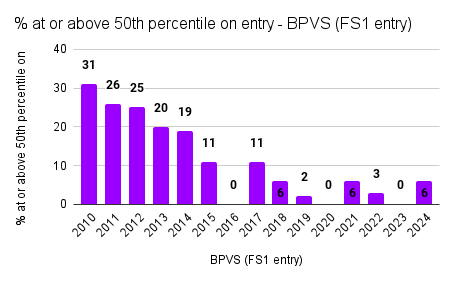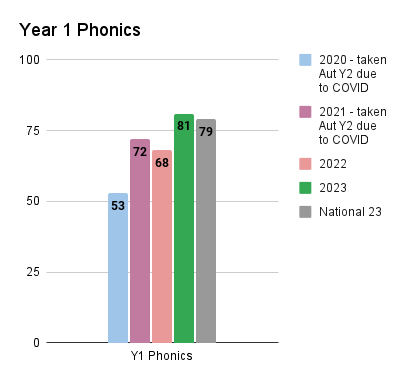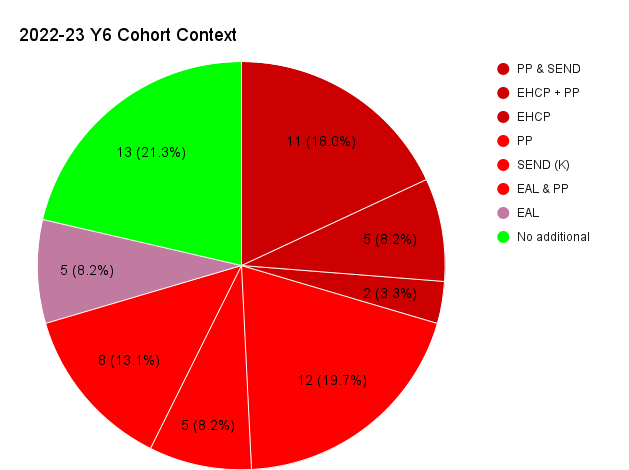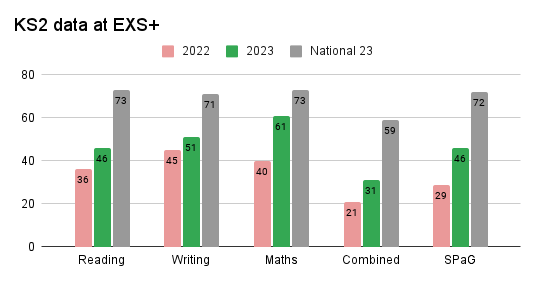Data
Context
The complexity of need is high. Almost 70% of children are entitled to Pupil Premium. Many children are disadvantaged through more than one indicator. A child is more likely to be FSM and SEND and also receiving support through social services, multi-agency or school pastoral teams whilst living in significantly challenging circumstances than not.
When compared to starting point on entry to Foundation Stage our children's progress is good.
How well are children achieving when they enter the school?
The British Picture Vocabulary Score is an assessment of children’s language on entry to the school in Foundation Stage. Language deprivation is increasing for cohorts entering the school with the vast majority of pupils significantly below their age expected when they arrive. The expected centile for a child is 50.
- 2023/24 BPVS data shows:
- 2 children were assessed at 50th+ centile, 6% of the cohort (ARE+)
- 51% of the cohort achieved an age standardised score placing them at less than the 10th centile. The percentage of children achieving in the lowest 10% continues to increase overtime. (44% in 2022/23)
- 37% of the cohort entered at the 1st centile, the lowest possible starting point.
How well do children in Y1 achieve?
- 81% of pupils passed Phonics Screening Check, which is above the National Average (79%) for the first time.
- There has been significant increases in outcomes from 2016 to 2023 of +29% achieving a pass.
- 84% of disadvantage learners passed PSC up from 57% in the previous year.
- 72% of pupils with SEND passed PSC an increase of 31% from 2022.
How well do children in Y6 achieve? (End of KS2)
|
KS2 2023 (excl IRU)
Reading attainment at EXS +4% compared to 2022
Reading attainment at GDS +5% compared to 2022
Writing attainment at EXS 0% compared to 2022
Writing attainment at GDS +2% compared to 2022
Maths attainment at EXS +14% compared to 2022 (within 10% of the national average)
Maths attainment at GDS +10% compared to 2022
- Maths attainment is the highest achieved overtime (since the change in assessment criteria in 2016).
- The percentage of pupils achieving EXS+ in reading has continued to increase over time, with 2023 figures being the highest to date. (excluding IRU pupils)
- The percentage of pupils achieving EXS+ in writing was maintained from the previous year. The impact of COVID lockdowns on this cohort during their time in Y3 and Y4 has been most significant in writing progress over time. Writing is a focus in the School Improvement and Development Plan.
- Progress scores in reading have improved over time since 2017 however progress in reading remains furthest from 0 (compared with writing and maths). Reading progress is a whole school priority action.
Progress and average score at the end of KS2 2023
| Progress score |
Average Scaled Score
|
|
| Reading | -2.6 | 99 |
| Writing | -1.7 | No data |
| Maths | -0.2 | 101 |
| SPAG | No data | 98 |
The table presents the end of KS2 progress data average (this shows above or below expected progress between KS1 and KS2 tests) and the scaled average score for the cohort also. The national average scaled score is 105 in Reading, 104 in Maths and 105 in SPAG.
Performance Tables
A link to the DfE school performance tables website
http://www.education.gov.uk/cgi-bin/schools/performance/school.pl?urn=133994&superview=pri



























